3 December 2024
After years of waiting, we’ve finally got a new Wahoo cycling GPS – and it’s a beast. At least, in terms of size and weight. And in the future, Wahoo also hopes in terms of features and position in the market. The new unit sports a full color touchscreen display, roughly similar to that of cell phones, while also including a speaker, bike-bell, and wind sensor. Of course, like other high-end bike computers introduced this year, it also includes a much higher price tag – $599USD.
Unfortunately, to spoil this review – it’s half-baked. It’s missing a vast array of features that previously existed on every other Wahoo bike computer to date, missing features listed on the front of the box and marketing site, and the battery life falls far short of claims. I’d argue this is the perfect product to see which reviewers are actually riding with it, versus just taking pretty shots of it.
But, we’re getting ahead of ourselves here. I’ve been riding the crap out of it, everything from near-daily 3-4 hour rides, to mountain biking, structured workouts, gravel riding, and more. All with the goal of figuring out what actually works.
Finally, note that this unit is a media loaner, and once this review is complete, it will go back to Wahoo. As always, I don’t accept advertising from any company I review – so, if you found this review useful, consider becoming a DCR Supporter, which gets you an ad-free site, plus the behind-the-scenes video series between both myself (and my wife) on everything that happens in the DCR Sports Tech Cave/universe.
How it Differs:

In some ways, it’s hard to compare a watermelon to a kiwi, as that’s roughly what it’s like comparing the Wahoo ACE to a Wahoo ROAM. So yes, while both are fruit (bike computers), beyond that, there’s actually quite a bit different – both good and bad. Still, assuming the standard Wahoo bike computer as a baseline (which is a massive assumption as you’ll see), here’s the most notable differences:
– Increased size of unit a cargo-ship-sized boatload
– Increased screen size to 3.8” (2.7” on ROAM V2)
– Increased screen colors to 16 million (64 colors on ROAM V2)
– Added touchscreen capability
– Added a very loud bike bell (digital)
– Added voice navigation prompts
– Added wind sensor
– Added new sensor pairing dashboard
– Added map layers option
– Added Activity Profiles (e.g. Road/MTB/etc…)
– Added time to upper edge, and always-on/seen
– Revamped ‘Ready to Ride’ dashboard
– Changed to Wahoo App (from Wahoo ELEMNT App)
– Changed a ton of the user interface
– No more lights/LED’s along upper edge
– No Live Tracking yet (firmware update in H1 2025)
– No Strava Live Segments yet (firmware update in H1 2025)
– No more full-route elevation view (coming in TBD update)
– No more filtering of routes on device (coming in TBD update)
– No more naming of saved locations (coming in TBD update)
– No more custom alerts (e.g. hydration/nutrition alerts, coming in update)
– No more choosing location on Wahoo App map to route to (only device)
– No nacho cheese dispenser
– No TrainerRoad Outside Workouts at present (‘coming soon’)
– Increased battery life claim to 30 hours (Note: This isn’t even vaguely close to real, as I’ll show)
– Increased internal storage from 32GB to 64GB (for maps)
– Included new aluminum mount (versus plastic previously)
– Price is $599USD/
Now, when it comes to features that are in the pipeline, Wahoo has confirmed some of them, per the table below, though, many of the ones listed above don’t have exact dates yet.
The first set is these updates:
“Planned December 2024 Updates. A post launch update will take place in December. This update will include the following features below:
– Strava Live Segments
– Offline configuration support (to supplement cloud based architecture)
– “Workout Profiles” rebrand to “Activity Profiles”
– Additional UI/UX Refinement and bug fixes”
And then the second category is this, for H1 2025 and H2 2025.

For example, language support includes focusing on French, German, Spanish, and then the remaining 14 languages Wahoo currently supports. Today, it’s only English on the ACE. For advanced route management, that’s allowing you to ride routes on a trainer, while showing the virtual route location on your map on the ACE.
So with that, let’s get into the box.
In the Box:

First up we’ll quickly get the unit unboxed. Inside, you’ll find the ACE just chilling:

But here’s what’s inside the box once you get rid of all the paper. Kudos to Wahoo in that there’s no plastic in the box.

Inside you’ve got:
– The beefcake of a bike computer (ACE)
– The beefcake of a metal mount
– The lanyard to tether the ACE in case it snaps the mount
– The USB-C cable to charge it
– A warranty paper you’ll never read.
Here’s a few close-up shots of all those things.



Ok, let’s get into the size. Or, over the size. Or, wrap ourselves around the size.
The Size:

Like it or not, the size is going to be a polarizing aspect of the Wahoo ACE. And it’s near impossible to understand in photos. It’s not really due to any singular dimension, but rather, the complete girthiness of it. It’s a tank in all ways.
Officially it measures 208g on the scale, but it’s mostly the thickness and width you’ll notice. Here’s how it looks side-by-side:

The thing is, I’m a unique duck here. I’m used to all assortment of stupid-large things on my handlebars for testing, including drone remote controls and more. So frankly, the size actually doesn’t bother me. Neither does the weight.

However, it’s impossible not to notice it. It’s huge. Wahoo says much of the size is to account for the larger battery, which in turn provides it with a claimed 30 hours of battery life (a number I can’t get *anywhere near* in my testing).
When it comes to mounts, it has much the same problem as the Edge 1050 did at launch – it needs an XL mount of some sort. In Wahoo’s case though, that’s actually twofold. First, it needs a strong (realistically metal) mount to support the much heavier weight. Very heavy, so heavy in fact that Wahoo is specifically not designing a GoPro adapter for the bottom of their mount because the combined weight will likely snap it (after hitting a pothole or cobbles).
Here’s their stock mount on my mountain bike:

The second piece is the length. It needs to be long enough to handle that, which is longer than the Edge 1050, but because the mount is centered differently than the Edge 1050, it can squeeze into most Edge 1050 compatible mounts. But barely. In the case of my Canyon bike with the stock Canyon out-front mounts, it basically skids (physically touches) across the handlebar as I rotate inwards:


But it does get in there, after snuggling. And that particular mount is designed to support a light on the bottom, so it’s used to the weight. Though, I haven’t tried it with both Wahoo ACE + Light to see if it’ll snap. Here’s to hoping it doesn’t.
Point is, this will be frustrating for some users (actually, many users) that want to mount a GoPro or other action camera below. The combined weight is simply well beyond what any mount on the market today is going to safely handle (I’ve snapped metal mounts with far less weight on it). Hopefully we’ll see some viable Ace+GoPro mounts soon. After all, Wahoo does have GoPro action cam control on the unit.
Riding Basics:

Probably the first thing you’ll need to know is to be using Wahoo’s new bike computer app on your smartphone, simply called ‘Wahoo’. Previously with their bike computers you used the Wahoo ELEMNT app. But over the last year or two, Wahoo’s been slowly moving devices under the consolidated Wahoo App instead. At a high level, this works. But if you’re a long-time Wahoo user, you’ll quickly find the gaps for which there are no solutions.
Within the Wahoo app, you’ll pair up the Wahoo ACE as well as link any partner accounts you have, like Strava, TrainingPeaks, or Komoot. However, the list is a bit messy right now. A number of the existing Wahoo partners aren’t working in the new Wahoo app/platform, which is required for the ACE.
Further, one thing that’s rather silly, is that by default, it won’t automatically upload your completed activities to each of these platforms. You have to expand out the box and check ‘Auto-Share’. Why?!? So much why.

Within the Wahoo app you can setup heart rate zone, and power zones (plus bits like metric/imperial/custom display of measurements).


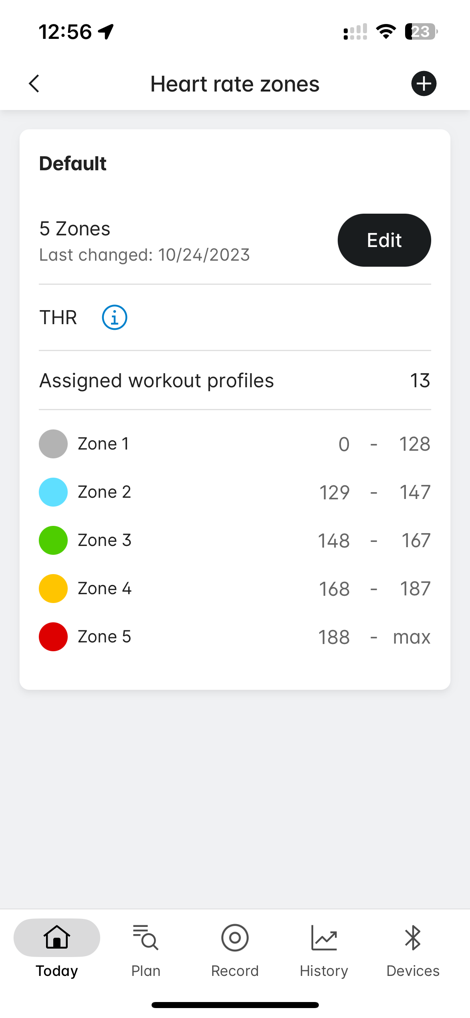
Next, this is the first Wahoo cycling computer to support sport/bike profiles, such as creating a set of data pages for road cycling, and a different one for mountain biking. To do so, you’ll open the Wahoo app, and then select to ‘Add Workout Profile’. Here you’ll choose something within the ‘Cycling’ category, in order to get it to show up on the ACE:



Here I’ve created a Mountain Biking profile, where I can then configure workout pages, alerts, general settings (such as Auto Lap), as well as heart rate zones:



When it comes to workout data pages, there’s boatload of options as before, both in terms of custom data fields, as well as dedicated pages like Music Control, GoPro Control, and Strava Live Segements (when that feature gets rolled out in a few months).
Once you’ve got all that configured, you can then select it at the top of your ACE:

After which, all of your data pages/settings/etc will be available for that ride.
But here’s the (extremely annoying) rub: This won’t correctly tag the ride type on Strava or other platforms upon upload. The *singular* feature that people have been asking for, for countless years, Wahoo hasn’t completed. Thus everything is listed on Strava as a generic ride, unless you go on Strava and manually toggle it to Mountain Bike, Gravel, etc…
Wahoo says that them adding in the correct sub-type is on their near-term radar, but don’t have a timeframe for it. Keeping in mind, this is literally just a single field in the .FIT file they have to set.
In any event, with all that configured, let’s go and ride. Again, I’ll cover navigation later on. As you ride, you’ll see your data pages automatically displayed. You can swipe through them using your fingers, or, press the page button:

You’ll notice above the coloring for my heart rate and wattage, this is based on my zones. It’s a nice touch that Wahoo has, and also appears in other fields like gradient.
Wahoo also has the concept of increasing/decreasing data field quantities. Meaning, by simply pressing the up/down buttons (on the right side), it’ll change how many data fields are displayed on the page, per the priority you set on the app. As you do this, it’ll change how big each field is. Such as below:


Note that while Wahoo got rid of the LED bar seen on past Wahoo computers, it does retain much of that same concept through colorized data fields and a strip that updates at the top of the screen. Further, I appreciate always having the time displayed at the top of the screen, no matter what data page you’re on. They also use that area to display upcoming turns (albeit, kinda late usually).
Next, regardless of whether you have a route enabled or not, you’ll automatically get upcoming climb information. As you approach a climb it’ll automatically trigger and show you details of that upcoming climb, such as this:
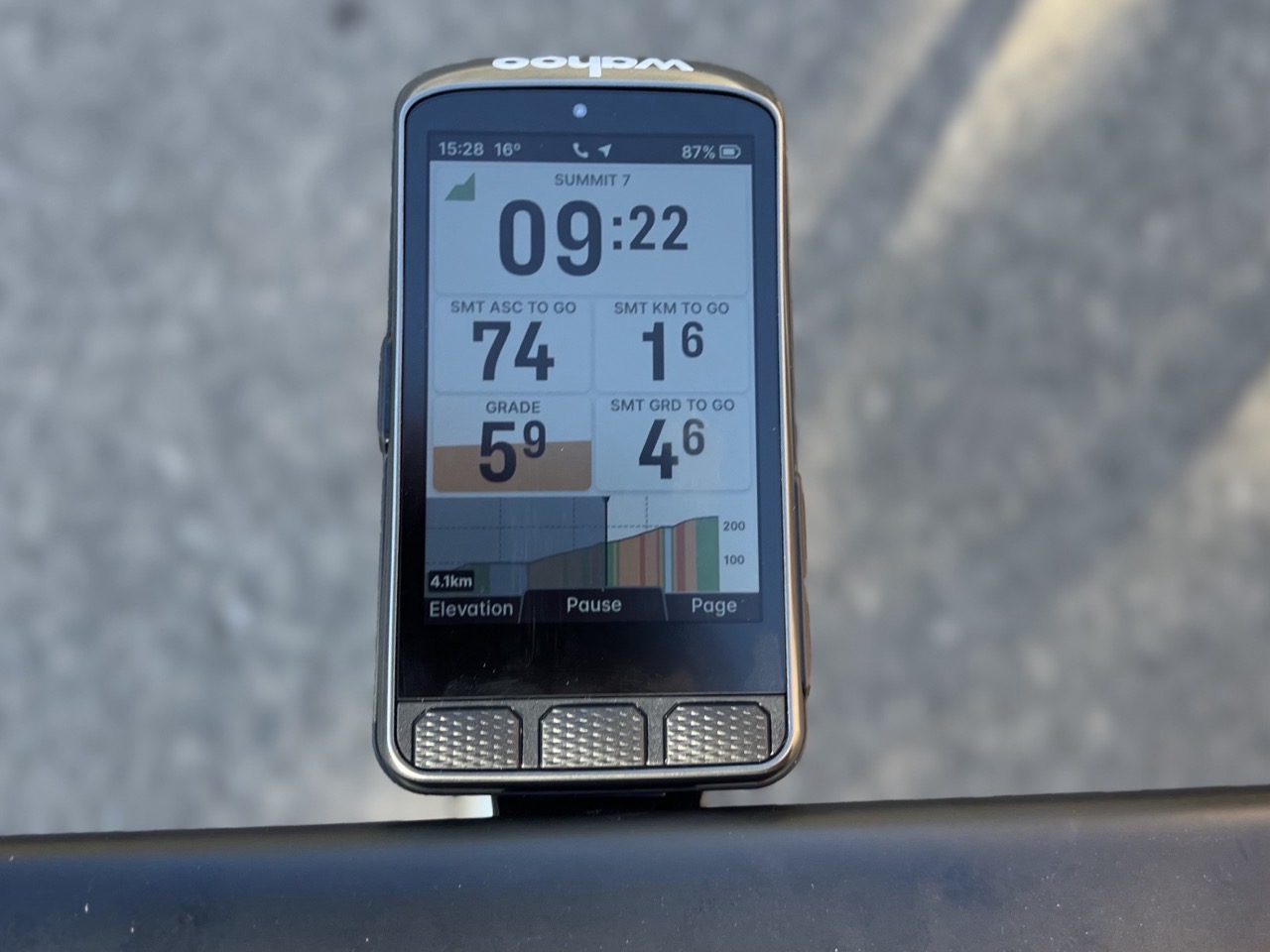
You’ll see details about the gradient displayed within the color of the chevrons on the map. You can tap through a few different data pages that show details about the climb.
Next, you can execute structured workouts from Wahoo’s own app, or TrainingPeaks. At present, TrainerRoad is not yet supported. As part of the migration to the Wahoo App, these connections haven’t been completed yet. And others are missing as well. TrainerRoad says that’s coming soon.
In any case, you can open up the structured workout on the workouts page to see a list of scheduled workouts. In my case, I manually created one in TrainingPeaks, since my TrainerRoad ones weren’t coming through anymore.

As you execute it, you’ll see details about each step automatically, and alerts accordingly…sometimes. You see, there’s a ton of bugs here.
– Skipped showing the progress bar during the warmup
– Didn’t show any interval alerts if I wasn’t on the interval page (so if I was on another data page, zero notification of the start of an interval)
– Didn’t adhere to TrainingPeaks ‘pause till lap’ option
– Didn’t show my current power line, as Wahoo’s own marketing site says it should
I do like the little pop-over at the bottom, but again, it only shows on the workout page, which kinda defeats the point of a popover.

And here’s Wahoo’s page (main Wahoo ACE site), indicating I should be seeing my actual power line shown, but it doesn’t work either:

Finally, with everything finished, you can end your ride. Here you’ll get a ride summary screen, with information as such:



That said, one super frustrating piece is that despite having the new activity profiles (e.g. Mountain Bike, Gravel, etc…), none of those carry into Strava. Wahoo isn’t setting that attribute like all of their competitors are, and thus, you’ll still need to update these in Strava after the fact.
Nonetheless, all of your data otherwise does appear correctly there.
The Bike Bell:
I was going to include the bike bell within the ‘Basics’ section above, but I figured I’d break it out. If for no other reason than to have one section that’s mostly positive.
Somewhat humorously, Wahoo seemed keen to hide its best feature. All of Wahoo’s initial PR efforts almost entirely ignored the bike bell. Thankfully, at the last minute they changed their mine. The Wahoo digital bike bell allows you to double-tap the screen to instantly hear a very loud and audible bike bell sound. It’s virtually indistinguishable from the Garmin Edge 1050 bike bell/sound.
It’s hard to visually show you the bike bell, because there’s no menu item. It just exists audibly, as as noted, you can double-tap anywhere on the screen to make it sound instantly.
Well, sorta.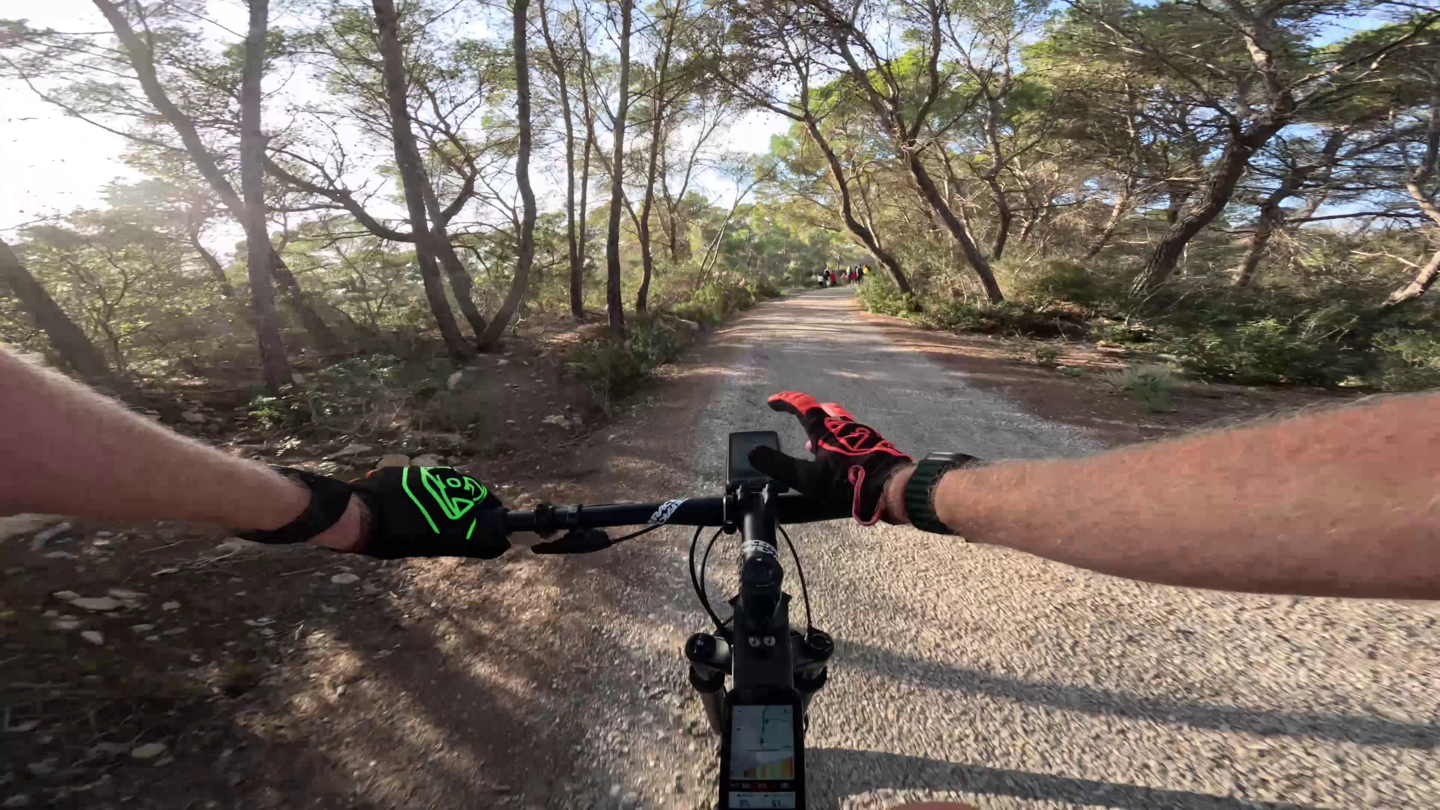
As long as that screen isn’t the map screen. For some odd reason, it doesn’t work on the map screen. Wahoo said that was because there was concerns about people using touch on that screen and thus accidentally ding-donging. Except, by default touch on the map screen is already disabled (it has that little lock icon at right). Thus, no amount of rubby-rubby would have moved the map anyway. Certainly, simply unlocking the screen would have disabled the bike bell? Or, using the accelerometer to detect a double-tap would have been possible, no?
In any event, that (moderate) annoyance aside, the bike bell is awesome. You can also tap just below the pause button in the center of the screen:
One other thing to note about the bike bell is that it’s *always* at full volume. Meaning, no matter what settings you configure the rest of your audio alerts for (e.g. a less imposing volume), the bike bell remains the same volume. I appreciate this.

However, I should also mention that unfortunately there is no method to configure the bike bell from the shifter buttons like on the Garmin Edge 1050 (or Hammerhead Karoo 3), which allows you to configure the extra shifter/bonus buttons to trigger the bike bell, which is super cool. Hopefully Wahoo will add that down the road.
Navigation:
When it comes to navigation, the ACE can route much the same as past Wahoo devices, though, there are some differences to be aware of that we’ll dive into.
First though, is getting routes to your device. For most people, those routes will come from platforms like Strava, Komoot or other 3rd party entities. That said, you can import GPX/FIT/TCX files directly into it, using the Files app on your phone, and opening it with the Wahoo app. Or selecting a previous route from history.
Once that’s done, it’ll show up on the ‘Routes’ listing on your service, such as this:

That said, at the moment, this Routes listing is a giant shaker bottle of routes, without any ability to order the routes. In my case, I had Strava routes from years ago import in, which is fine. But what’s not fine is that I can’t sort them in any way. I can only search them by name, which then requires me to remember exactly what I named each route that someone else might have created. Most bike computers, including all of Wahoo’s existing ones, have a sorting option at the top (such as by Date, A-Z, Starred, Length, and Proximity – as is the case on the Wahoo ROAM V2). Despite showing this on Wahoo’s marketing site, it’s not there today:

Wahoo says this will come at some point, hopefully soon. This is one of a number of examples of things being shown on the box, that are not on the unit in real-life.
In any case, once you’ve managed to find your route and select it, you’ll see an elevation profile and overview of the route.

I do appreciate the easy option to ‘Reverse’ the route though, something that despite all logic and years of requests, doesn’t exist on a Garmin Edge series device (but does exist on their wearables).

With the route loaded, we’ll head out riding. If we were to look a the map page first, you’ll see the route as a series of chevrons on the route line. Moreover, the color of those chevrons indicates the climb gradients as you ride along, which is clever/handy:

I do appreciate the coloring and map styles here. The way Wahoo has selected to colorize the different bits of info on the map screen (such as other streets/landscapes/etc…) makes this screen really easy to understand, and the thick chevrons make it easy to confirm your direction at a glance. That said, when dimmed (as effectively required to get half-decent battery life), it’s much harder to read.
If you tap the layers icon, you can adjust various map layers including points of interest, custom waypoints, street names, wind, and Summit Segments. Note that in this context, ‘Wind’ doesn’t mean an overlay of the wind direction/forecast, but rather, just wind from the wind sensor.

Likewise, you can tap to enable the cue sheet as well at any time, if you’d prefer to see that:

In the event you’re on another data page (not the map page), and you have an upcoming turn, it’ll show a turn written prompt and give you an audible alert, and even voice directions to turn.
But again, there’s two problems here. First, by default none of these occur. You need to enable these Voice turn alerts in the settings. Why on earth navigation and voice prompts aren’t enabled by default is beyond my pay grade.
However, that gets to the second issue, the speaker volume. To be very clear: The speaker is loud AF (which is great for certain things). Seriously, it’s bone-jarringly loud. So loud your riding buddies will quickly try and body-check you into the nearest heard of cows they can find.
Fear not though, Wahoo has a solution for that, the volume slider. This slider has three levels: Loud AF, blah, and unbearable.

For navigation voice prompts, Loud AF is OK. I’d quibble that the voice should be slightly higher pitched, so it’s easier to hear in the wind, but that’s an easy change they could make. However, once you go down to the middle option, the voice is impossible to hear in the wind. And while the bike bell ignores the volume settings (as it should), there isn’t a way to separate voice prompt volume from the rest of the beeps your unit makes.
Again, their competitors have two sliders for a reason here: Voices are harder to hear in the wind than high-pitched beeps. Anyone who’s gone on a ride with friends knows this.

In any case, back to our ride. The next piece is your route profile that’s showing the elevation profile up ahead, seen at the bottom there. That elevation profile shows the next 2KM of your route….and only the next 2KM of your route:

While past Wahoo units allowed far greater lengths than that (cough…the entire route), the ACE is limited here to 2KM.
Once again, the Wahoo box (and everything on the Wahoo site) shows this enumerating the full route as an elevation profile (showing ’Total’). And again, I’m not trying to be nit-picky here, but rather illustrating that this unit simply isn’t ready. Hard stop.

I know this may come as a surprise to some: But stop shipping products that don’t do what it says on the box and your marketing site. Simply delay. The fastest way to get a reviewer angry is to literally not do the thing printed on the front of your box.
Next, when it comes to on-demand routing, you can save locations at any point and navigate back to them, as well as drag to a point on the map (on unit) and route to it. Both of these are under the ‘routes’ option, then ‘Route To’ option).
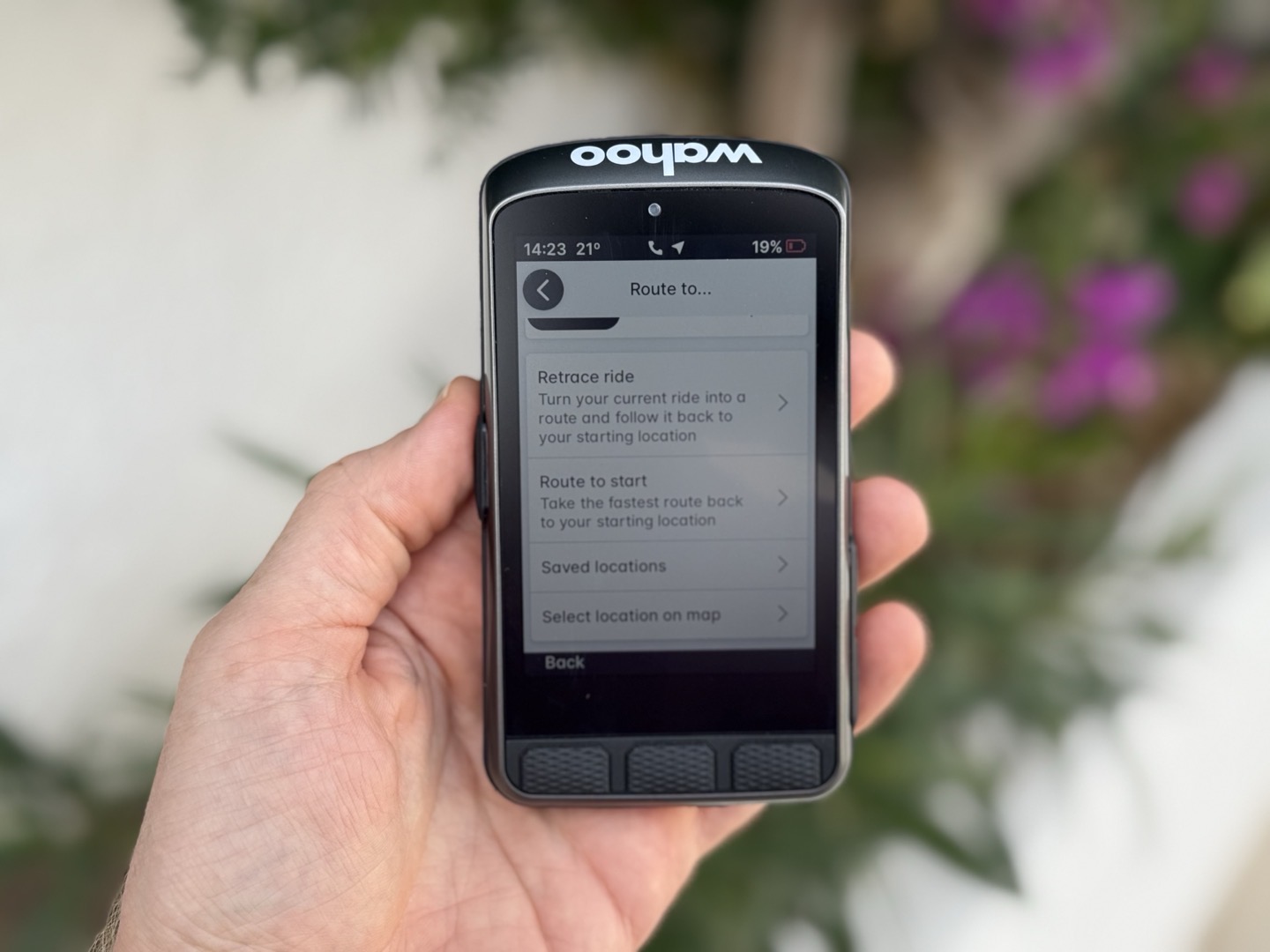
These worked perfectly fine, and instantly, for me. Except the ability to renamed saved waypoints, that doesn’t work at all right now. Thus, it’s just named whatever random street name you tapped (not ‘Home’ or ‘Work’ or ‘Hot Dog Stand’). Wahoo says that’s on the way too, though that too is listed as being a current feature on their marketing site.
Likewise, the ability to select a point on the map from the Wahoo app doesn’t work either anymore (coming soonish). However, you can send a location from Google Maps or Apple Maps to the Wahoo app, and that worked intermittently to me.
Finally, it should be noted that there are existing navigation providers that Wahoo hasn’t yet ported to the new Wahoo app yet. There’s no timelines on these, other than the second half of next year. But exactly which ones are getting re-added isn’t clear.
The Wind Sensor:

Repeat after me: This is not an aero sensor, this is not an aero sensor, this is not an aero sensor.
It is however, a wind sensor capable of measuring wind speed coming into it. And while most aero sensors have that same starting point, that’s about where it ends. In fact, the jump from measuring aerodynamic drag is massive – but not so much hardware, rather, software and user education. It’s why almost every company that enters the cycling aero sensor landscape has failed. And almost all of those remaining that haven’t failed, have invariably pivoted towards coaching services instead. So get aero sensor out of your head, and let’s focus on what it actually is.
Instead, the Wahoo ACE has a wind sensor for measuring the wind speed, then combining it with your known ground speed, and calculating whether you’ve got a headwind, tailwind, or some sort of drafting boost. It calls this “Wahoo Wind Dynamics”, which admittedly makes me giggle a little bit like a 6-year old boy and think about the “wind dynamics” after eating Taco Bell.
While riding, Wahoo gives you a single color-coded data field, titled Airspeed, which is shown in either Airspeed MPH or Airspeed KPH, just like the below (lower half is Airspeed, I’ve added ground speed to the upper half):

The coloring is basically the following groupings:
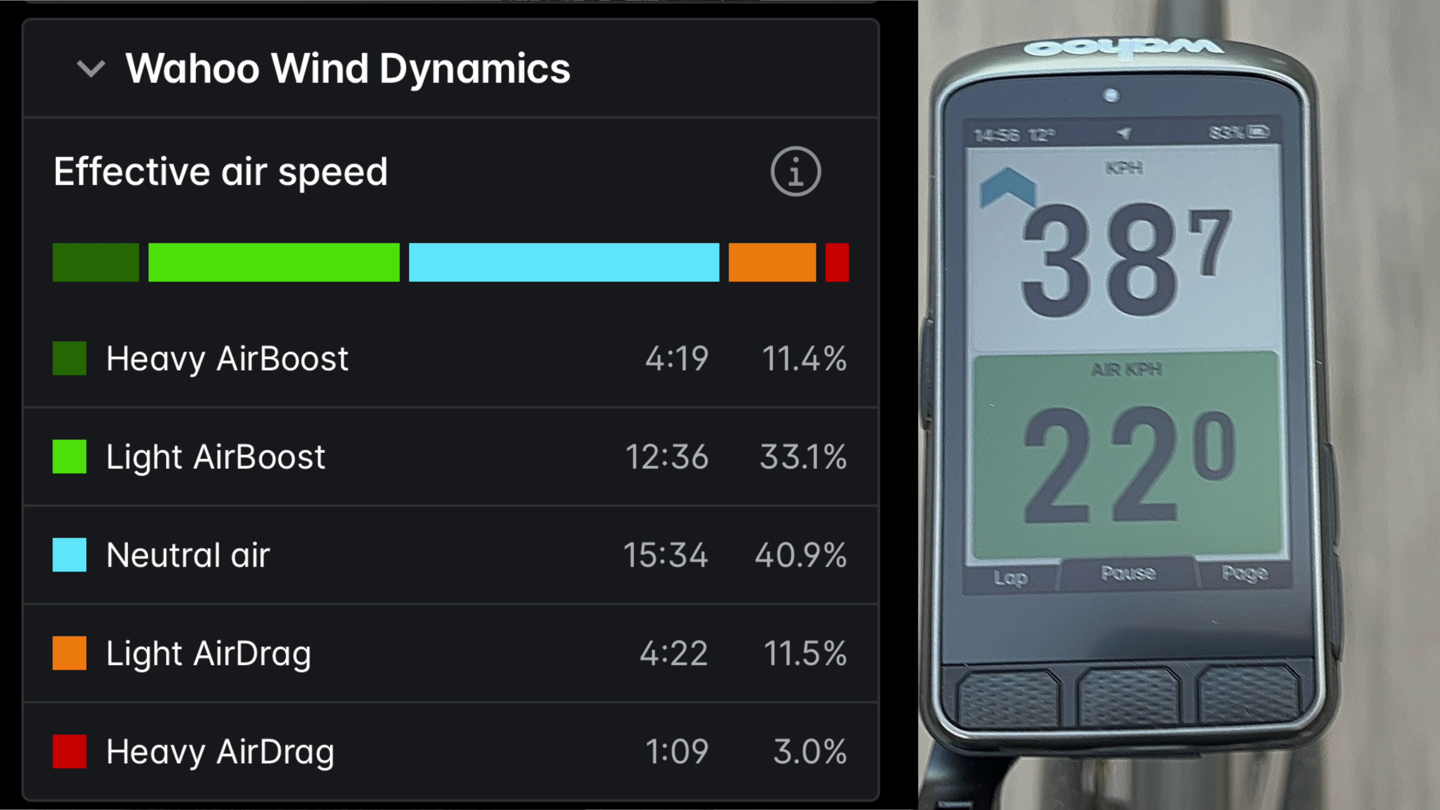
The idea being you can quantify how much you’re saving when you tuck in behind someone to draft, because you’ll see those two numbers differ. If the AirSpeed is higher than the ground speed, you’ve got a headwind. If it’s lower, you’ve either got a tailwind or are drafting.
I could then take the ground speed number, compared it to the airspeed number, do some mental math, and figure out exactly what the wind speed is (tailwind or headwind). Which…is yes, as silly as it sounds. To me, I shouldn’t have to be doing mental math on a ride constantly. It should simply do this automatically, and instead show me the final number – as either a headwind or tailwind/draft.

At the end of the ride, you’ll see the numbers shown on the unit with percentages of time spent in the different color coded zones (labeled as either AirBoost or AirDrag):

My complaint here isn’t adding a wind sensor to the Wahoo bike computer. Instead, it’s that it’s just not providing any value beyond what I already know. And the singular area it could have provided value (showing impacts of drafting), it’s far too cumbersome of a number to be constantly doing mental math on. Just give me number that we’re all calculating in our heads anyway.
Long term, it remains to be seen how Wahoo can leverage this differently. I don’t see any viable path for Wahoo to use this for CdA calculations. Plenty of companies have tried, and given up there. Not because the tech wasn’t ready, but because 98% of riders don’t understand the *VAST* amounts of knowledge required to get proper aero testing done. Silly things like knowing the difference between your shoulders being firm or relaxed will hugely impact testing. Or that moving your fingers 1cm will impact testing. Or doing multiple test runs, etc…
It’s why virtually every aero sensor company on the market today that started life as a consumer aero sensor company/device, has shifted to being a coaching device, whereby the coach goes and does a seminar first to learn how to use the aero sensor, and then spends an absurd amount of time with athletes ensuring they execute tests correctly.
Point is, I feel like that weight could have been much better spent on an LED light (even as an emergency light because you’re running behind, or a built-in safety camera (akin to Cycliq Fly12), or…anything else.
Battery Burn:
Look, it’s not good. There’s no two ways to say it. It falls *FAR* short of their claims of 30 hours of battery life, and is roughly in-line with the Hammerhead Karoo 3’s battery life when the Karoo 3 is at 50% brightness (which is far brighter than the ACE screen can go). It falls behind the Garmin Edge 1050’s battery burn, and is leagues behind the Edge 1040 or Edge 1040 battery. Again, in real-life numbers.
So, let’s look at the official claim and then a crap-ton of testing I’ve done. Officially, the claim is simply “30+ hours”.
But more officially, Wahoo clarified the actual claim is ’30 hours of GPS battery life with the backlight in 5-second off setting’. This means that after 5 seconds of touching the unit, the backlight turns off, and is unreadable depending on your lighting conditions. When in direct sunlight – no problems. But in the winter shade? Problems, especially on screens with smaller fonts (more data fields), or zoomed out maps.
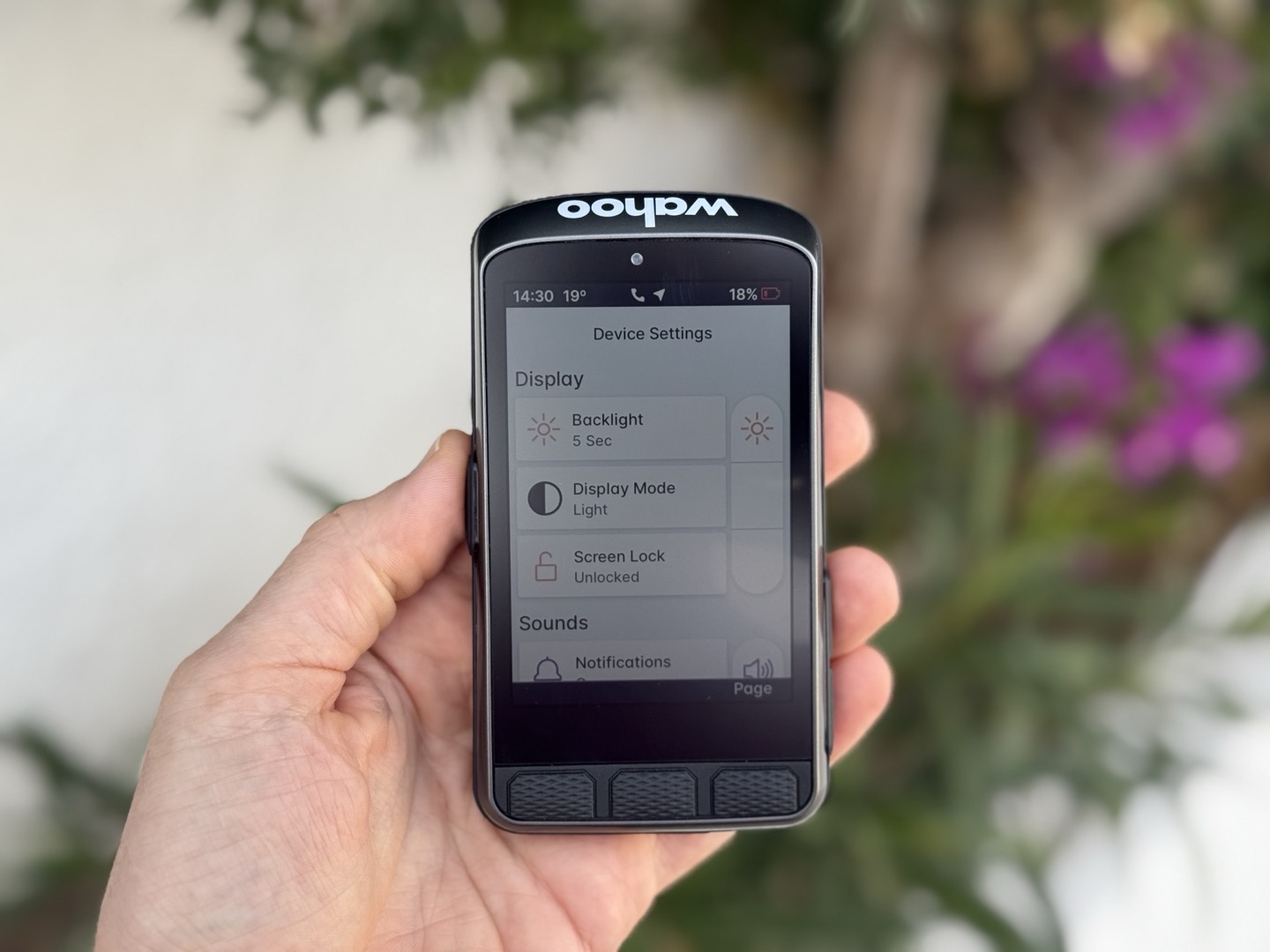
Even worse, the default configuration setting for the Wahoo ACE is the so-called “Auto” mode, which basically just keeps the backlight on at the brightness you specify. In the mode, I was burning roughly 8-12%/hour (across numerous 3-4 hour rides), depending on exactly which screen I was on. Yes, that puts it on target for 10-15 hours of battery life.
The ‘best’ battery scenario I could muster was 5.71%/hour (thus 17-hours) when I set it for 5-second off, on a mountain bike ride two days ago. Though, one couldn’t see the screen half the time, and given I was mountain biking, it wasn’t like I could just touch the screen easily to see it again.

Interestingly, after a bunch of rides and different configurations, I noticed:
– Plain data field pages obviously burned the least battery, though, if they had any color blocks in them (e.g. zone changing color blacks), they *destroyed* battery life, even more than the map page. This was true even with just two data fields, if one was color (e.g. the wind page),
– There was no meaningful difference in the number of sensors paired impacting battery life.
– There was no obvious difference between having navigation enabled or not, battery life seemed to burn equally.
– None of these figures include LiveTracking or Strava Live Segments, as both are unavailable at this time. Further, none of these figures included screen recording enabled.
– As noted, by far, the biggest impact was which backlight time setting was enabled.
Now Wahoo says a secondary low-power saving backlight mode is coming in the first half of 2025. This mode will find a better balance between the backlight setting and battery burn. Though honestly, I’m not convinced that’s the issue. I think Wahoo needs to look more carefully at the rest of the code running and optimize there instead.
The reason I say that, is if we look at the Hammerhead Karoo 3 and Edge 1050, both of which have *FAR* more demanding screens (in terms of battery burn), both can outperform it, even in far brighter settings with far smaller batteries. And then if we look at similar screen technology types, like the Edge 1040, that too easily outperforms it on any setting you want.
Point is, I don’t really understand why the battery burn is as bad as it is, for as big a battery as Wahoo has. And while I say the term “bad” here despite the Hammerhead Karoo 3 being similar, keep in mind the Karoo is basically half the size, and far brighter.
Final Thoughts:

Cyclists kept asking Wahoo to make a bike computer with a better and bigger display, and on that specific point, they checked the box. In fact, I’ll even agree that their new home screen/dashboard is better than before. And that their map styling pages are very solid. And yes, the bike bell is awesome. Seriously, that’s (by far) the best feature on this unit.
But in almost every other category, Wahoo simply launched this device too early, and at too high of a price relative to their competitors or the capabilities the ACE has today. It lacks significant features and integrations seen on the Wahoo ROAM V2 or BOLT V2 (their current bike computers), and falls far short of the claimed 30 hours of battery life in my testing. And that’s before we talk about the screen visibility, or the value of the aero sensor. I just don’t understand why Wahoo keeps launching bike computers too early each time, while sticks the landing perfectly on trainer launches most times. There was zero reason to launch this in early December, versus waiting till next March.
In fact, it seems to be an industry trend this year. We saw the COROS Dura launch far too early, so much so the company then had to repeatedly delay shipping for both hardware and software reasons. We’ve seen startups JESPR and Absolute One also launch at both crazy-high prices and with the feature sets of a 2012 bike computer. Still, Hammerhead did launch their Karoo 3 this past spring to appropriate pricing, finished features with most of the polish required, and solid accuracy. And Garmin also launched their Edge 1050 this past summer at the same price as their previous top-end device, with virtually no complaints from reviewers or consumers alike.
The problem is, launching unbaked early gets you reviews like this. Reviews that live for *years* on the internet. Sure, perhaps I’ll update it as Wahoo improves in future firmware, but that won’t change the YouTube video which can’t be updated. And sure, I could publish another YouTube video down the road each month they restore new features, but reviews months later rarely top the charts in consumer searches.
I want companies like Wahoo or COROS to challenge the growing bike computer monopoly. I think both have significant unique things to offer there. In the case of COROS, it’s crazy battery life and extremely good pricing. In the case of Wahoo it tends to be simplicity and use of ease. But launching half-baked products like this only damages their reputation, furthering their competitors position.
Sigh.
With that, thanks for reading (or supporting independent reviews like this)!